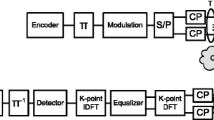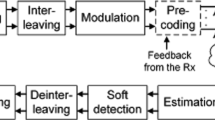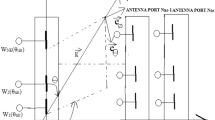Abstract
We summarize our recent state-of-the-art programmable and reconfigurable detector and QR decomposition (QRD) implementations targeting 3G long term evolution (LTE) downlink and uplink requirements. The downlink transmission is based on the orthogonal frequency division multiplexing, whereas the uplink transmission uses a single-carrier frequency-division multiple access. The downlink implementations are based on the programmable transport triggered architecture (TTA) which provides a flexible and energy efficient architecture template. In TTA detector implementation, the LTE detection rate requirements up to 20 MHz bandwidth and 4 × 4 antenna system with 64-QAM, are achieved by using 1–6 programmable cores in parallel. Each core runs at 277 MHz clock frequency and consumes 55.5–64.0 mW depending on the detector configuration. The downlink detector is based on the selective spanning with fast enumeration algorithm. The uplink field-programmable gate array (FPGA) detector implementation is targeted for 4 × 4 antenna system and 64-QAM achieving a detection rate requirement for 20 MHz bandwidth. The used FPGA board for uplink implementation is Xilinx Virtex-6 and the implementation has been carried out using Xilinx Vivado high level synthesis tool. Two different detector architectures are implemented. The first one achieves the detection rate requirement with a single processing block running at 231 MHz and the latter one with four blocks in parallel, each running at 247 MHz. The implemented detector is based on the K-best algorithm. A multiple-input multiple-output receiver requires QRD to produce valid inputs for the detector. In addition to detector implementations, QRD is also implemented on both TTA and FPGA. Modified Gram–Schmidt algorithm is used in both QRD implementations.







Similar content being viewed by others
References
Ketonen, J., Karjalainen, J., Juntti, M., & Hänninen, T. (2011). MIMO detection in single carrier systems. In Proceedings of European Signal Processing Conference.
Janhunen, J., Pitkänen, T., Silvén, O., & Juntti, M. (2011). Fixed- and floating-point arithmetic processor comparison for MIMO–OFDM detector. IEEE Journal of Selected Topics in Signal Processing, 12(99), 1.
Hochwald, B., & ten Brink, S. (2003). Achieving near-capacity on a multiple-antenna channel. IEEE Transactions on Communications. 51(3), 389–399.
Li, M., Bougart, B., Lopez, E., & Bourdoux, A. (2008). Selective spanning with fast enumeration: A near maximum-likelihood MIMO detector designed for parallel programmable baseband architectures. In Proceedings IEEE International Conference on Communications, Beijing, China (pp. 737–741).
Yoo, B., Lee, K., & Lee, C. (2007). Implementation of IEEE 802.16e MIMO–OFDMA systems with K-best lattice decoding algorithm. In Proceedings of IEEE International Consumer Electronics, Seoul, Korea. (pp. 68–73).
Antikainen, J., Salmela, P., Silvén, O., Juntti, M., Takala, J., & Myllylä, M. (2007). Transport triggered architecture implementation of list sphere detector. In Proceedings of Finnish Signal Processing Symposium, Oulu, Finland.
Antikainen, J., Salmela, P., Silvén, O., Juntti, M., Takala, J., & Myllylä, M. (2007). Application-specific instruction set processor implementation of list sphere detector. EURASIP Journal on Embedded Systems, 2007.
Antikainen, J., Salmela, P., Silvén, O., Juntti, M., Takala, J., & Myllylä, M. (2007). Fine-grained application-specific instruction set processor design for the K-best list sphere detector algorithm. In Proceedings of IEEE International Conference on Embedded Computer Systems: Architecture, Modeling and Simulation, Samos, Greece (pp. 108–115).
Fasthuber, R., Li, M., Novo, D., Raghavan, P., Perre, L.V.D., & Catthoor, F. (2010). Exploration of soft-output MIMO detector implementations on massive parallel processor. (pp. 1–18).
Li, M., Novo, D., Bougart, B., Desset, C., Dejonghe, A., Perre, L. V. D., & Catthoor, F. (2011). Energy aware signal processing for software defined radio baseband implementation. 63(1), 13–25
Guo, Z., & Nilsson, P. (2006). Algorithm and implementation of the K-best sphere decoding for MIMO detection. IEEE Journal of Selected Areas in Communications, 24(3), 491–503.
Chen, S., Zhang, T., & Xin, Y. (2007) Relaxed K-best MIMO signal detector design and VLSI implementation. IEEE Transactions on Very Large Scale Integration Systems, 15(3), 328–337.
Studer, C., Burg, A., & Bolcskei, H. (2008). Soft-output sphere decoding: algorithms and VLSI implementation. IEEE Journal of Selected Areas in Communications, 26(2), 290–300.
Myllylä, M., Juntti, M., & Cavallaro, J. (2010). Implementation aspects of list sphere decoder algorithms for MIMO-OFDM systems. Elsevier Journal on Signal Processing, 90(10), 2863–2876.
Myllylä, M., Cavallaro, J., & Juntti, M. (2011). Architecture design and implementation of the metric first list sphere detector algorithm. IEEE Transactions on Very Large Scale Integration Systems, 19(5), 895–899.
Ketonen, J., Juntti, M., & Cavallaro, J. (2010). Performance-complexity comparison of receivers for a LTE MIMO-OFDM system. IEEE Transactions on Signal Processing, 58(6), 3360–3372.
Amiri, K., Cavallaro, J. R., Dick, C., & Rao, R. M. (2009). A high throughput configurable SDR detector for multi-user MIMO wireless systems.
Wu, M., Gupta, S., Sun, Y., & Cavallaro, J. (2009). A GPU implementation of a real-time MIMO detector. In Proceedings on IEEE Works on Signal Processing Systems, Tampere, Finland (pp. 303–308).
Wu, M., Sun, Y., & Cavallaro, J. (2009). Reconfigurable real-time MIMO detector on GPU. In Proceedings of Annual Asilomar Conference in Signals Systems, Computers, Pacific Grove, CA, USA (pp. 690–694).
Wu, M., Sun, Y., Gupta, S., & Cavallaro, J. (2010). Implementation of a high throughput soft MIMO detector on GPU. pp. 1–14.
Wu, M., Sun, Y., & Cavallaro, J. (2010). Implementation of a 3GPP LTE turbo decoder accelerator on GPU. In Proceedings of IEEE Works on Signal Processing Systems, San Francisco, CA, USA. (pp. 192–197).
3rd Generation Partnership Project (3GPP). Retrieved Sept 6, 2011 from http://www.3gpp.org.
Jääskeläinen, P., Guzma, V., Cilio, A., & Takala, J. (2007). Codesign toolset for application-specific instruction-set processors. In Proceedings of SPIE Multimedia on Mobile Devices, pp. 65 070X-1–65 070X-11.
Shabany, M., Su, K., & Gulak, P. (2008) A pipelined scalable high-throughput implementation of a near-ML K-best complex lattice decoder. In Proceedings of IEEE International Conference Acoustics Speech, and Signal Processing (pp. 3173–3176).
Kung, S. (1985). VLSI array processors. IEEE ASSP Magazine, 2(3), 4–22.
Golub, G.H., & Loan, C. F. V. (1989). Matrix Computations (2nd ed.). Baltimore: The Johns Hopkins University Press.
Lomont, C. (2003). Fast inverse square root, Tech. Rep.
Eberly, D. (2010). Fast inverse square root (revisited), Geometric Tools, LLC, Tech. Rep.
Acknowledgments
The authors would like to thank Xilinx Inc., especially J. Noguera, B. Ozgul and J. Keskinen, for the possibility to evaluate Xilinx Vivado High Level Synthesis tool and for their co-operation. The authors would also like to thank J. Ketonen for her efforts related to this paper.
Author information
Authors and Affiliations
Corresponding author
Rights and permissions
About this article
Cite this article
Hänninen, T., Janhunen, J. & Juntti, M. Novel detector implementations for 3G LTE downlink and uplink. Analog Integr Circ Sig Process 78, 645–655 (2014). https://doi.org/10.1007/s10470-013-0128-5
Received:
Revised:
Accepted:
Published:
Issue Date:
DOI: https://doi.org/10.1007/s10470-013-0128-5




